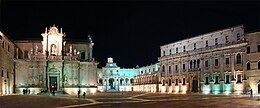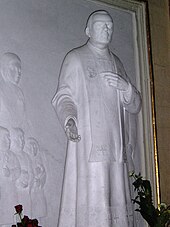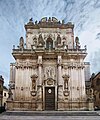Lecce
Lecce
| |
|---|---|
| Comune di Lecce | |
 Clockwise from top left: Church of Santa Croce; Roman Theatre; the cathedral's bell tower; Lecce Cathedral ("Cattedrale di Santa Maria Assunta"); and Porta Napoli, in Viale Università | |
UTC+2 (CEST) | |
| Postal code | 73100 |
| Dialing code | 0832 |
| Patron saint | Orontius |
| Website | www |



Lecce (
Because of its rich
Lecce is home to the University of Salento.[9]
History
According to legend, a city called Sybar existed at the time of the
Under the emperor Hadrian (2nd century AD) the city was moved 3 kilometres (2 miles) to the northeast, taking the name of Licea or Litium. Lecce had a theater and an amphitheater and was connected to the Hadrian Port (the current San Cataldo). Orontius of Lecce, locally called Sant'Oronzo, is considered to have served as the city's first Christian bishop and is Lecce's patron saint.[11]
After the fall of the
.After the
In 1656, a plague broke out in the city, killing a thousand inhabitants.
In 1943,
Main sights
Churches and religious buildings
- Church of the Holy Cross: construction of the Chiesa di Santa Croce) was begun in 1353, but work halted until 1549, and it was completed only by 1695. The church has a richly decorated façade with animals, grotesque figures and vegetables, and a large rose window. Next to the church is the Government Palace, a former convent.
- Lecce Cathedral: the church was originally built in 1144, rebuilt in 1230, then totally restored in the 1659–70 by Giuseppe Zimbalo, who also built the five storey 70-metre (230 ft) high bell tower, with an octagonal loggia.
- Tancred of Sicily in 1180. In 1716 the façade was rebuilt, with the addition of numerous statues, but maintaining the original Romanesqueportal. The walls were frescoed during the 15th-17th centuries.
- Celestine Convent: built (1549–1695) in Baroque-style by Giuseppe Zimbalo. The courtyard was designed by Gabriele Riccardi.
- Santa Irene: this church was commissioned in 1591 by the Michael the Archangel by Guido Reni. The high altar has a Transport of the Holy Ark by Oronzo Tiso. In the right transept is one of the largest altars in Lecce, dedicated to Saint Cajetan (1651). Nearby is the Rococo altar of Saint Andrew Avellino. Also from the mid-17th century is the Altar of St Orontius by Francesco Antonio Zimbalo, followed by the altar of Saint Irene with a canvas by Giuseppe Verrio (1639), nine busts of saints housing relics and a large statue of the saint. The altar of Saint Stephen has the Stoning of St. Stephen by Verrio.[13]
- San Matteo: this church was built in 1667. It has a typical central Italy Baroque style. It has two columns on the façade, only one of which is decorated, though only partially. According to a local legend, the jealous devil killed the sculptor before he could finish the work.
- Santa Maria degli Angeli
- Santa Chiara: this church was built in 1429–1438, rebuilt in 1687.
- San Francesco della Scarpa: known as the "church without façade" as the latter has been demolished in the 19th century restorations. The most ancient section dates likely to the 13th-14th centuries; the interior is on the Greek Cross plan. Notable are several Baroque altars and a large statue of Saint Joseph.
Other buildings
- Column of statue of St Oronzo: (Lecce's patron) was given to Lecce by the city of Brindisi, because Saint Oronzo was reputed to have cured the plague in Brindisi. The column was one of a pair that marked the end of the Appian Way, the main road between Rome and southern Italy.
- Torre del Parco ("Park Tower"): is one of the medieval symbols of Lecce. It was erected in 1419 by the then-18 year old Giovanni Antonio Del Balzo Orsini, prince of Lecce. The tower, standing at more than 23 metres (75 ft), is surrounded by a ditch in which bears (the heraldic symbol of the Orsini del Balzo) were reared. The whole complex was the seat of Orsini's tribunal and of a mint, and after Giovanni Antonio's death, it became a residence for the Spanish viceroys.
- Palazzo Sedile: was built in 1592 and was used by the local council until 1852.
- Castle of Charles V: built in 1539–49 by Gian Giacomo dell'Acaja. It has a trapezoidal plan with angular bastions. It is attached to the Politeama Greco Opera House, inaugurated on 15 November 1884.
- Triumphal Arch (Arco di Trionfo, commonly called Porta Napoli, "Neapolitan Gate"), which is one of the three gates to enter Lecce's historical city centre, erected in 1548 in honor of Charles V. It replaced an older gate, Porta S. Giusto, which, according to tradition, lay over the tomb of the namesake saint. Also built over pre-existing medieval gates are the current Porta San Biagio ("St. Blaise Gate") and the Porta Rudiae which are the other two gates to Lecce's Historical city centre. Both are in Baroque style, the latter having the statue of St. Oronzo on the top and mythological figures on the sides.
- Palazzo dei Celestini: now seat of the Province of Lecce. It was built in 1659–95 and designed by Giuseppe Zimbalo.
- The city's obelisk: erected in 1822 in honour of Ferdinand I of the Two Sicilies.
-
Piazza Sant'Oronzo
-
Piazza del Duomo
-
Basilica di Santa Croce
-
Church of San Giovanni Battista
-
Palazzo dei Celestini
-
Roman Theatre (2nd century AD)
-
Torre del Parco
-
Arco di Prato
-
Porta Rudiae
Gardens and parks
- Orto Botanico di Lecce, a botanical garden.
Archaeology
- The Roman 2nd century amphitheatre, situated near Sant'Oronzo Square, was able to seat more than 25,000 people. It is now half-buried because other monuments were built above it over the centuries. The theatre is currently used for different religious and arts events.
- The archaeological museum Sigismondo Castromediano.
- The archaeological museum Faggiano.
- The archaeological park of Renaissance Humanist who was from the region.[14] This was once the more important city until Roman times and has an amphitheatre of its own, a necropolisand remains of substantial walls. The Porta Rudiae, built on the road leading from this site, is named after it.
Geography
Climate
Lecce experiences a Mediterranean climate (Köppen climate classification Csa).
| Climate data for Lecce | |||||||||||||
|---|---|---|---|---|---|---|---|---|---|---|---|---|---|
| Month | Jan | Feb | Mar | Apr | May | Jun | Jul | Aug | Sep | Oct | Nov | Dec | Year |
| Record high °C (°F) | 21.2 (70.2) |
22.4 (72.3) |
28.6 (83.5) |
30.4 (86.7) |
35.6 (96.1) |
44.0 (111.2) |
44.4 (111.9) |
42.6 (108.7) |
40.6 (105.1) |
34.2 (93.6) |
26.8 (80.2) |
21.4 (70.5) |
44.4 (111.9) |
| Mean daily maximum °C (°F) | 13.0 (55.4) |
13.5 (56.3) |
15.7 (60.3) |
18.9 (66.0) |
24.4 (75.9) |
29.0 (84.2) |
31.7 (89.1) |
31.5 (88.7) |
27.5 (81.5) |
22.3 (72.1) |
17.3 (63.1) |
14.0 (57.2) |
21.6 (70.8) |
| Daily mean °C (°F) | 8.6 (47.5) |
8.9 (48.0) |
10.6 (51.1) |
13.5 (56.3) |
18.2 (64.8) |
22.5 (72.5) |
25.0 (77.0) |
25.2 (77.4) |
21.8 (71.2) |
17.5 (63.5) |
12.8 (55.0) |
9.6 (49.3) |
16.2 (61.1) |
| Mean daily minimum °C (°F) | 4.2 (39.6) |
4.2 (39.6) |
5.6 (42.1) |
8.0 (46.4) |
12.1 (53.8) |
15.9 (60.6) |
18.4 (65.1) |
18.9 (66.0) |
16.0 (60.8) |
12.7 (54.9) |
8.3 (46.9) |
5.3 (41.5) |
10.8 (51.4) |
| Record low °C (°F) | −12.0 (10.4) |
−5.6 (21.9) |
−4.6 (23.7) |
−1.8 (28.8) |
3.2 (37.8) |
7.4 (45.3) |
10.4 (50.7) |
10.8 (51.4) |
6.0 (42.8) |
1.1 (34.0) |
−2.8 (27.0) |
−5.4 (22.3) |
−12.0 (10.4) |
| Average precipitation mm (inches) | 60.3 (2.37) |
61.3 (2.41) |
62.4 (2.46) |
45.5 (1.79) |
27.6 (1.09) |
20.4 (0.80) |
16.2 (0.64) |
36.0 (1.42) |
54.3 (2.14) |
91.0 (3.58) |
95.1 (3.74) |
68.9 (2.71) |
639 (25.15) |
| Average precipitation days (≥ 1.0 mm) | 7.87 | 6.9 | 6.87 | 6.2 | 4.37 | 3 | 1.9 | 2.24 | 4.77 | 6.33 | 7.77 | 7.8 | 66.02 |
| Average relative humidity (%)
|
78.29 | 75.61 | 73.85 | 72.68 | 69.21 | 66.29 | 65.24 | 66.72 | 72.37 | 77.08 | 80.02 | 79.51 | 73.07 |
| Average dew point °C (°F) | 5.77 (42.39) |
5.73 (42.31) |
7.14 (44.85) |
9.65 (49.37) |
12.49 (54.48) |
15.54 (59.97) |
17.44 (63.39) |
18.84 (65.91) |
17.13 (62.83) |
14.64 (58.35) |
11.17 (52.11) |
7.23 (45.01) |
11.90 (53.41) |
| Source 1: | |||||||||||||
| Source 2: altervista[17](extremes) | |||||||||||||
Sport
Lecce is home to
Transportation
Lecce is served by Lecce railway station. The local public transport includes trolleybus service, introduced in 2012.[18][19]
People

- Antonio Amantea (1894–1983), World War I fighter ace
- Scipione Ammirato (1531–1601), historian and philosopher
- Giuseppe Ayroldi (1895 – 1962), represented Lecce in the Constituent Assembly
- translator
- Carmelo Bene (1937–2002), actor, film director and screenwriter
- Vittorio Bodini (1914–1970), poet and translator
- Enciclopedia Treccani), who served in the government of Italy as Minister of Culture
- Carlo Capasa (born 1958), president of Camera Nazionale della Moda Italiana
- CoSTUME NATIONAL
- Franco Causio (born 1949), retired footballer, 1982 FIFA World Cup winner
- Antonio Conte (born 1969), retired footballer, former manager of Juventus FC, Chelsea F.C, Tottenham Hotspur F.C., and Italian football team
- Francesco Danieli (born 1981), historian and iconologist
- Cosimo De Giorgi (1842–1922), scientist
- Ennio De Giorgi (1928–1996), mathematician
- Cloe Elmo (1910–1962), opera singer
- Quintus Ennius(c. 239–169 BC), Roman writer and poet
- Vito Fazzi (1851–1918), physician and hospital founder
- Barbara Lezzi (born 1972), politician, who served in the government of Italy as Minister for the South
- Marco Materazzi (born 1973), retired footballer, 2006 FIFA World Cup winner
- Gabriele Poso (born 1978), independent artist, musician and composer
- Michelangelo Schipa (1854–1939), writer, historian and scholar
- Tito Schipa (1888–1965), tenor
- Filippo Smaldone (1848–1923), Catholic priest and saint
- Antonio Verrio (c. 1636–1707), painter in England
Twin towns – sister cities
 Murcia, Spain, since 2004
Murcia, Spain, since 2004 Skopje, North Macedonia, since 2005
Skopje, North Macedonia, since 2005 Ostrów Wielkopolski, Poland, since 2006
Ostrów Wielkopolski, Poland, since 2006 Valladolid, Spain, since 2009
Valladolid, Spain, since 2009 Amasya, Turkey
Amasya, Turkey
See also
- Roman Catholic Archdiocese of Lecce
- Punta San Cataldo di Lecce Lighthouse
- Brindisi Airport
- Port of Brindisi
Notes
- romanized: Loupíai[6]
References
- ^ L'Italia dialettale (1976). L'Italia dialettale, Volume 39. Arti Grafiche Pacini Mariotti. p. 250.
Dialetto romanzi, in centric he circondano, senza allontanarsene troppo, l'area ellenofona, cioè Melpignano (dove il dialetto griko non è ancor del tutto morto), Vernole, Lecce, S. Cesario di Lecce, Squinzano, San Pietro vernotico, Cellino S. Marco, Manduria, Francavilla Fontana, Maruggio: può essere perciò legittimo pensare ad un'origine grika del verbo in questione, con estensione successiva al dialetti romani. Il neogreco presenta una serie di voci che si prestano semanticamente e foneticamente
- Iapygesare lost to history.
- ^ "Superficie di Comuni Province e Regioni italiane al 9 ottobre 2011". Italian National Institute of Statistics. Retrieved 16 March 2019.
- ^ "Popolazione Residente al 1° Gennaio 2018". Italian National Institute of Statistics. Retrieved 16 March 2019.
- ^ "Lecce". Merriam-Webster.com Dictionary. Retrieved 30 June 2019.
- ^ Rohlfs, Gerhard (1964). "Toponomastica greca nel Salento" (PDF) (in Italian). p. 13. Archived from the original (PDF) on 1 August 2017. Retrieved 22 August 2017.
Ancient Greek name of Lecce according to Strabo.
- ^ "Lecce: Italy". Lifeinitaly.com. 10 November 2009. Retrieved 26 March 2013.
- ^ "Investigation on porosity change of Lecce stone". Archived from the original on 23 May 2012. Retrieved 9 October 2008.
- ^ "Università del Salento". Ministero dell'Istruzione dell'Università e della Ricerca (in Italian).
- ^ Stillwell, Richard; et al. "LUPIAE (Lecce) Apulia, Italy". The Princeton Encyclopedia of Classical Sites.
- ^ Rita Parisi (14 February 2022). "Sant'Oronzo, la storia del patrono di Lecce" (in Italian).
- ^ "Le incursioni aeree alleate in Puglia nell'estate 1943". Il Corriere Salentino (in Italian). 25 March 2018.
- ^ Luigi Bove (15 February 2019). "La chiesa di Sant'Irene dei Teatini a Lecce" (in Italian).
- ^ Pietro Napoli Signorelli, Vicende della coltura nelle due Sicilie, Naples 1784, Vol.1, p.246ff
- )
- ^ "World Weather Information Service". World Weather Information Service.
- ^ "Lecce Galatina".
- ^ Lehmann, Jürgen (16 January 2012). "Lecce (IT) - Finally opened!". TrolleyMotion. Archived from the original on 23 January 2021. Retrieved 28 January 2021.
- ISSN 0266-7452.
- ^ Lecce: "Gemellaggi" Archived 19 August 2014 at the Wayback Machine, 3 November 2011, retrieved 16 August 2014
External links
- Official website (in Italian)














